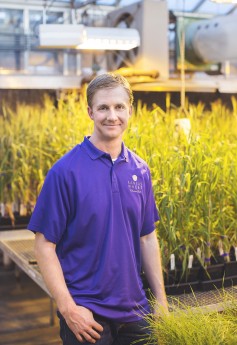Breadcrumb
- Home
- Recent news stories
- High-quality bread wheat reference genome sequence on horizon, would help feed world

Jesse Poland, assistant director of Kansas State University's Wheat Genetics Resource Center, is part of a collaborative public-private project for an improved whole genome assembly of bread wheat. (Image courtesy of KSU)
Using NRGene's trademarked DeNovaMAGIC software and Illumina's sequencing data for assembly, the project team is well on its way to sequencing the bread wheat variety Chinese Spring, said Jesse Poland, an assistant professor of plant pathology and assistant director of the Wheat Genetics Resource Center at Kansas State University.
A high-quality whole genome reference sequence — a complete map of the entire genetic makeup from one end of the chromosome to the other for all 21 bread wheat chromosome pairs — is less than two years away, Poland said, and will dramatically accelerate global research into crop improvement of the world's most staple crop.
The public-private collaborative sequencing project is coordinated by the International Wheat Genome Sequencing Consortium and led by Poland; Nils Stein of IPK Gatersleben in Germany; Curtis Pozniak of the University of Saskatchewan's Crop Development Centre in Canada; and Andrew Sharpe of the Global Institute for Food Security in Canada. Project participants also include researchers from Illumina Inc.; NRGene in Israel and the U.S.; Tel Aviv University in Israel; and the French National Institute for Agricultural Research.
"This improved assembly of the wheat genome is an excellent resource to move forward with genomics assisted breeding," Poland said. "With wheat being such an important crop for Kansas, projects like this will continue to enable our world-class research efforts in wheat at Kansas State University to understand the wheat genome and produce better varieties."
To understand the significance of this achievement, Poland said it is important to understand why sequencing the wheat genome continues to be such a massive undertaking. The wheat genome itself is huge, with a total of 16 billion base pairs of DNA — compared to other significant staple crops like rice and corn, which have 430 million and 2.5 billion respectively. Building a full-reference sequence with that many pieces has traditionally been virtually impossible, Poland said, but with the help of NRGene's trademarked DeNovaMAGIC technology and Illumina's sequencing technology, the reality is in sight.
"Having the whole genome sequence is like providing an instructional manual for building better plants," Poland said. "Until now, the pages in the manual were out of order and 40 percent of them were missing. Having a complete manual, with everything in the right order, will allow us to quickly identify genes responsible for traits such as pest resistance, yield and quality. With this genomic information we could potentially make the breeding cycle two to three times faster, and bring better varieties to farmers in a fraction of the time."
According to the United Nations, 70 percent more food will be needed by 2050. As global populations grow and available land and water become scarcer, the pressure is on crop and trait improvement to meet the wheat productivity increase that is needed. This high-quality reference genome sequence will provide the genomic keys necessary to ensure an abundant supply of wheat for the years to come, Poland said.
The project was coordinated through the International Wheat Genome Sequencing Consortium with funding from Genome Canada, Genome Prairie, Saskatchewan Ministry of Agriculture, the Saskatchewan and Alberta Wheat Development Commissions, and the Western Grains Research Foundation through the Canadian Triticum Applied Genomics project; Kansas State University through the National Science Foundation's Plant Genome Research Program; and Illumina Inc.
The International Wheat Genome Sequencing Consortium, with more than 1,100 members in 55 countries, is an international, collaborative consortium, established in 2005 by a group of wheat growers, plant scientists, and public and private breeders. The goal of the consortium is to make a high-quality genome sequence of bread wheat publicly available in order to lay a foundation for basic research that will enable breeders to develop improved varieties.
By Haley Ahlers, Project Coordinator, KSU Plant Pathology, 785-532-2366, hahlers@k-state.edu
